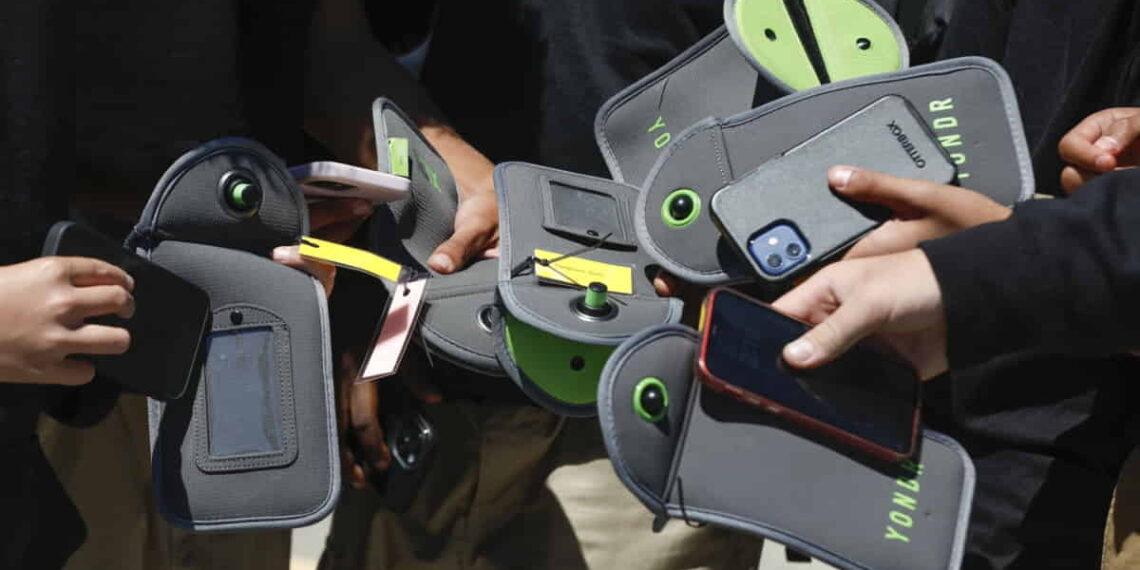Banning Cellphones in Schools: A Growing Bipartisan Trend
The idea of banning cellphones in schools has gained significant traction across the political spectrum, with support coming from both Republican and Democratic leaders. Arkansas’ Republican Governor, Sarah Huckabee Sanders, and California’s Democratic Governor, Gavin Newsom, are two notable figures who have endorsed this movement. As the issue gains momentum, at least eight states have implemented cellphone bans in schools over the past two years, and more states are considering similar measures in 2025.
The Growing Support for Cellphone Bans
The push for banning cellphones in schools is primarily driven by two concerns: the negative impact of screen time on children’s mental health and the disruptive nature of phones in the classroom. Teachers have expressed growing frustration over constant distractions, while mental health experts, such as Surgeon General Dr. Vivek Murthy, have urged schools to create phone-free environments to promote student well-being. Murthy has even suggested Congress require warning labels on social media platforms regarding their effects on young people’s lives.
Nationally, 77% of U.S. schools reportedly have policies prohibiting cellphones for non-academic purposes, according to the National Center for Education Statistics. However, this statistic is somewhat misleading as many schools struggle with enforcement and student compliance.
Kim Whitman, co-founder of the Phone-Free Schools Movement, explains that the issue is resonating across both red and blue states. “It doesn’t matter if you live in a big city or a rural town—children everywhere need a break from the pressures of phones and social media during the school day,” she said.
States Taking Action: A Bipartisan Shift
A growing number of states have already enacted or are considering cellphone bans in schools. These measures vary from state to state, but the trend is clear. Some notable examples include:
- Florida: In 2023, Florida became the first state to mandate a ban on cellphones during class time, requiring schools to block social media access on district Wi-Fi networks.
- California: A 2024 law requires the state’s nearly 1,000 school districts to develop their own cellphone policies by July 2026.
- Other States: States like Indiana, Louisiana, Minnesota, Ohio, South Carolina, and Virginia have passed or are contemplating similar laws, some offering funding for schools that adopt cellphone-free policies.
Additionally, Arkansas Governor Sarah Huckabee Sanders introduced a pilot program in 2024, offering grants to schools that implement phone-free policies. Over 100 schools have already joined, and in her recent State of the State address, Sanders proposed an outright statewide ban on cellphones in schools.
Other governors, including Kelly Ayotte of New Hampshire, Iowa’s Kim Reynolds, and Nebraska’s Jim Pillen, have also voiced support for cellphone restrictions. New York Governor Kathy Hochul has suggested she may push for a statewide policy, though details are still unclear.
The Opposition to Bans: Safety Concerns and Practicality
Despite the growing support for cellphone bans, the proposal has faced opposition, particularly from some parents. Many argue that cellphones are an essential tool for communication, especially in emergencies. In the wake of tragic school shootings, some parents have pointed out that students relied on their phones to contact loved ones during crises.
However, proponents of the bans argue that phones may pose additional risks in emergencies. Distractions could impede students’ ability to react quickly, and phones could inadvertently reveal a student’s location during an active shooter situation.
Opponents also highlight the practical concerns of parents who want their children to have access to phones for reasons such as coordinating transportation or staying in touch throughout the day.
Keri Rodrigues, president of the National Parents Union, shares concerns about the broader implications of social media on children. However, she argues that banning phones is an overly simplistic solution. “Banning phones during school won’t address deeper issues like bullying or the dangers of social media,” she said. “We need to teach kids the skills to navigate technology responsibly, not just take their devices away.”
Conclusion
The debate over banning cellphones in schools continues to grow, with bipartisan support from both Republican and Democratic leaders. While proponents argue the move will protect students from distractions and mental health issues, opponents emphasize the need for access to phones in emergencies and the importance of teaching children to navigate technology responsibly. As more states take up the issue in 2025, the balance between safety, practicality, and technology’s impact on youth remains at the forefront of the conversation.
This article was rewritten by JournosNews.com based on verified reporting from trusted sources. The content has been independently reviewed, fact-checked, and edited for accuracy, neutrality, tone, and global readability in accordance with Google News and AdSense standards.
All opinions, quotes, or statements from contributors, experts, or sourced organizations do not necessarily reflect the views of JournosNews.com. JournosNews.com maintains full editorial independence from any external funders, sponsors, or organizations.
Stay informed with JournosNews.com — your trusted source for verified global reporting and in-depth analysis. Follow us on Google News, BlueSky, and X for real-time updates.













